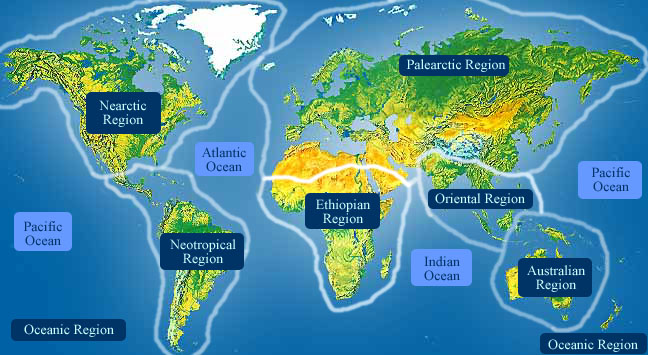Laterallus ruberruddy crake
Geographic Range
Laterallus ruber is found in the northern parts of South America and into the southern areas of North America. The highest densities found of the ruddy crake are in Columbia and Central America. This species favors the wetlands and wet forests throughout these areas.
(Peterson 1980)
- Biogeographic Regions
- nearctic
- neotropical
Habitat
Wet forests and swamps support Laterallus ruber.
Physical Description
Laterallus ruber superficially resembles other rails. This species has the characteristic short conical bill. The legs are long with wide spreading feet to move around in wet areas. The body shape resembles a water drop when the neck is extended. The feathers on the head are dull black. The rufous wings and the back have a reddish brown coloring mingled with brown and black. The male has a rusty red colored breast similar to the color of a ruddy duck. The female is only slightly more drab than the male. The tail is very short and stubby. A rusty colored stripe envelopes the dark eyes of the crake.
(Miller and Miller 1987)
- Other Physical Features
- endothermic
- bilateral symmetry
Reproduction
Information on reproduction is unavailable on Laterallus ruber. This information is general to crakes.
Crakes generally lay 6-12 eggs in a nest made among tall aquatic plants at the waters edge. Both male and female brood them in turn for up to 3 weeks. As incubation starts before all the eggs are laid, the chicks emerge at intervals over a period of several days. They can leave the nest shortly after hatching. After the eggs have hatched, the male cares for them while his mate incubates the younger eggs. After all the eggs have hatched, both parents guard the chicks, feeding them until they are a week old. Sometimes the chicks split into two parties, each under the charge of one parent.
- Key Reproductive Features
- iteroparous
- gonochoric/gonochoristic/dioecious (sexes separate)
- sexual
- oviparous
Behavior
- Key Behaviors
- flies
- motile
Communication and Perception
Food Habits
Laterallus ruber feed on the invertebrates and plants they can find living at the surface or just beneath the surface of the water. This species will also feed from the mud and decaying plants in wetlands and in pools formed in large tree crevices. They mainly prey on water snails and insects such as water beetles, mayflies and mosquitoes, as well as their larvae. Water plants and grass may also be eaten but this is unconfirmed.
(Miller and Miller 1987)
Economic Importance for Humans: Positive
The ruddy crake has no major economic value. Money from bird watchers and ecotourists can be accounted for but this species is not of major interest since other tropical birds are of greater interest.
Conservation Status
The largest concern for this species is the one common to most tropical birds. Deforestation and habitat destruction have lowered the populations of the ruddy crake. These birds have benefited from the parks and land preserved by governments and concerned groups.
-
- IUCN Red List
-
Least Concern
More information
-
- IUCN Red List
-
Least Concern
More information
-
- US Federal List
- No special status
-
- CITES
- No special status
Contributors
David Allen (author), University of Michigan-Ann Arbor, Terry Root (editor), University of Michigan-Ann Arbor.
Glossary
- Nearctic
-
living in the Nearctic biogeographic province, the northern part of the New World. This includes Greenland, the Canadian Arctic islands, and all of the North American as far south as the highlands of central Mexico.

- Neotropical
-
living in the southern part of the New World. In other words, Central and South America.

- acoustic
-
uses sound to communicate
- bilateral symmetry
-
having body symmetry such that the animal can be divided in one plane into two mirror-image halves. Animals with bilateral symmetry have dorsal and ventral sides, as well as anterior and posterior ends. Synapomorphy of the Bilateria.
- chemical
-
uses smells or other chemicals to communicate
- endothermic
-
animals that use metabolically generated heat to regulate body temperature independently of ambient temperature. Endothermy is a synapomorphy of the Mammalia, although it may have arisen in a (now extinct) synapsid ancestor; the fossil record does not distinguish these possibilities. Convergent in birds.
- iteroparous
-
offspring are produced in more than one group (litters, clutches, etc.) and across multiple seasons (or other periods hospitable to reproduction). Iteroparous animals must, by definition, survive over multiple seasons (or periodic condition changes).
- motile
-
having the capacity to move from one place to another.
- native range
-
the area in which the animal is naturally found, the region in which it is endemic.
- oviparous
-
reproduction in which eggs are released by the female; development of offspring occurs outside the mother's body.
- sexual
-
reproduction that includes combining the genetic contribution of two individuals, a male and a female
- tactile
-
uses touch to communicate
- visual
-
uses sight to communicate
References
B. Miller, C. 1987. Conservation of a Critical Marsh and Lowland habitat, Mussel Creek drainage system, Belize, C.A.. Report to NYZS/Wildlife Conservation Society..
McRae, E., 1994. The Birds of Belize's Coastal Zone: Species, Distribution, Current status, Threats to their well-being, and Potential Measures to Reduce their Impact.. Report to NPAMP..
Peterson, Roger Tory, 1980. Peterson Field Guides: A field guide to the birds of Texas. Boston: Houghton Mifflin Company.
